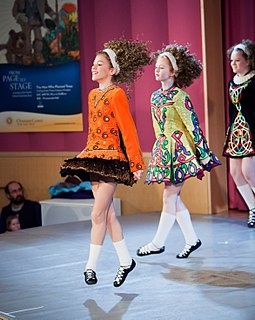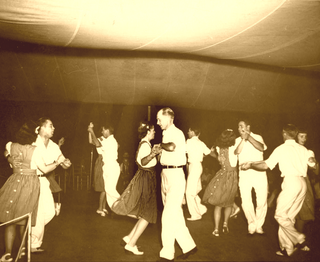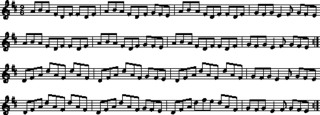This article needs additional citations for verification .(July 2011) (Learn how and when to remove this template message) |
In Irish traditional music, a slide (Irish : sleamhnán) is a tune type in 12
8 akin to, and often confused with, a single jig. Slides are played mostly in the Sliabh Luachra region of southwestern Ireland, but originate from quadrilles.

Irish is a Goidelic (Gaelic) language originating in Ireland and historically spoken by the Irish people. Irish is spoken as a first language in substantial areas of counties Galway, Kerry, Cork and Donegal, smaller areas of Waterford, Mayo and Meath, and a few other locations, and as a second language by a larger group of non-habitual speakers across the country.

The jig is a form of lively folk dance in compound metre, as well as the accompanying dance tune. It developed in 16th-century England, and was quickly adopted on mainland Europe where it eventually became the final movement of the mature Baroque dance suite. Today it is most associated with Irish dance music, Scottish country dance and the Métis people in Canada. Jigs were originally in duple compound metre,, but have been adapted to a variety of time signatures, by which they are often classified into groups, including light jigs, slip jigs, single jigs, double jigs, and treble jigs. There is also the reel and waltz.
Sliabh Luachra, sometimes anglicized 'Slieve Logher', is an upland region in Munster, Ireland. It is on the borders the counties Cork, Kerry and Limerick, and bounded to the south by the River Blackwater. It includes the Mullaghareirk Mountains.
Though slides contain the same number of beats per tune as a single jig, melodies are phrased in four rather than two beats. Consequently, single jigs are notated as having eight bars per part and slides as having four bars. Furthermore, the pace is quicker than single jigs, often around 150bpm. While single jigs are often danced solo by step dancers, slides are usually danced in groups by set dancers, sometimes in sets with polkas.

Irish stepdance is a style of performance dance with its roots in traditional Irish dance. It is generally characterized by a stiff upper body and quick and precise movements of the feet. It can be performed solo or in groups. Aside from public dance performances, there are also stepdance competitions all over the world. These competitions are often called Feiseanna. In Irish dance culture, a Feis is a traditional Gaelic arts and culture festival. Costumes are considered important for stage presence in competition and performance Irish stepdance. In many cases, costumes are sold at high prices and can even be custom made. Males and females can both perform Irish stepdance but for the most part in today's society, the dance remains predominantly female. This means that the costumes are mainly dresses. Each dress is different, with varying colors and patterns, designed to attract the judge's eye in competitions and the audience's eye in performance. General appearance besides the costume is also equally important. Dancers would typically curl their hair before each competition. Many dancers invest in curled wigs that match their hair color. Poodle Socks are worn with the dresses and shoes. These are white socks that stretch to mid calf with distinctive ribbing.
The polka is originally a Czech dance and genre of dance music familiar throughout Europe and the Americas. It originated in the middle of the 19th century in Bohemia, now part of the Czech Republic. The polka remains a popular folk music genre in many European countries, and is performed by folk artists in the Czech Republic, Germany, Austria, Slovenia, Switzerland, and Finland, and to a lesser extent in Poland, Latvia, Lithuania, the Netherlands, Hungary, Italy, Ukraine, Romania, Belarus, Russia, and Slovakia. Local varieties of this dance are also found in the Nordic countries, Spain's Basque Country, the United Kingdom, Ireland, Latin America and the United States.








